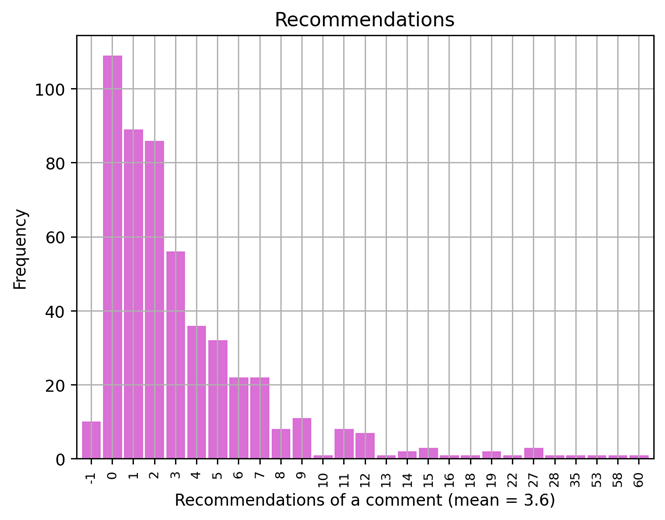 The Royal Town Planning Institute (RTPI)
The Royal Town Planning Institute (RTPI)
RTPI champions the power of planning in creating prosperous places and vibrant communities. We have over 25,000 members in the private, public, academic and voluntary sectors.
Using our expertise and research we bring evidence and thought leadership to shape planning policies and thinking, putting the profession at the heart of society's big debates. We set the standards of planning education and professional behaviour that give our members, wherever they work in the world, a unique ability to meet complex economic, social and environmental challenges. We are the only body in the United Kingdom that confers Chartered status to planners, the highest professional qualification sought after by employers in both private and public sectors.
About this paper
This study explores people’s views on post-pandemic cities with a particular focus on the future of high streets and town centres.
Report authors
Professor Aude Bicquelet-Lock, Deputy Head of Policy and Research, RTPI.
The author is very grateful to Dr. Anthony Lock for his help with the technical aspects of this research and to Jenny Divine for her diligent proofreading of this report.
You can download the report here or you can read it in full below:
Contents
About this research
Introduction
Background
Method
Results
HS.1 – Pre Covid-19 perceptions
HS.2 – May 2020 perceptions (Covid-19 first wave)
HS.3 – June 2020 perceptions (High Street Shops imminent reopening)
HS.4 – July 2020 perceptions (High Street Shops reopened with Social distancing measures)
HS.5 – August 2020 perceptions
Summary and conclusion
Appendix
About this research
What is this study about?
This study explores people’s views on post-pandemic cities with a particular focus on the future of High Streets and Town Centres.
Why does it matter?
While Covid-19 has forced built-environment experts and politicians alike to re-think the way we plan future towns and cities, the views of the public on the topic have largely remained absent from the debate. This absence is significant — especially as the impact of placemaking on people’s health and well-being has been widely acknowledged throughout the crisis.
This research brings the views of the public to the forefront of the debate on the future of High Streets and Town Centres in order to inform an inclusive and ‘bottom-up’ approach to urban design and planning policies post Covid-19.
What kind of evidence was collected?
Online comments posted under the Guardian were gathered, then analysed using sentiment analysis and text-mining techniques.
What are the key findings?
- There is very little difference between the remarks of online commenters about the future of High Streets posted before the onset of Covid-19, after the onset of Covid-19 and throughout the pandemic
- The main issues identified by commenters revolved around:
— Business rates
— Access
— Goods and Services offered by High Street Shops
- A majority of commenters believe that Covid-19 is mainly acting as a 'catalyst for change'; accelerating a transformation process that had commenced before the pandemic.
- A predominant idea among commenters seems to be that there will be 'no going back' to the 'old normal' in terms shopping habits — with a few suggesting that re-purposing old buildings in Town Centres will be inevitable in the near future.
- To revitalise High Streets and Town Centres, commenters suggested that two main avenues should be considered: (1) following the example of other European Cities and (2) capitalising on renewing social interactions in High Streets.
Introduction
As the Covid-19 crisis unfolds, built-environment professionals and place management experts have widely been invited to express their views on the impact of the pandemic on the future of towns and cities. In fact, the proliferation of digital platforms has now facilitated exchanges of views around the critical changes that the pandemic might bring in the way we work, meet and live our lives.
However, the views of the public have largely remained absent from the debate. Beyond anecdotal references to particular individuals or communities, systematic large-scale analysis of public perception regarding post covid-19 Cities remain non-existent. This is a significant absence – especially as the current crisis has further highlighted the impact of placemaking on people’s physical and mental health.
In fact, just a few months before the onset of the pandemic the planning community celebrated the 50th anniversary of the Skeffington Report – a key document extoling the virtues of public participation in planning decisions. Although participation and public engagement in planning (and public decision-making at large) have received huge attention over the last four decades, current trends suggest that enthusiasm for public engagement in planning has been somehow overtaken by experts’ views.
Of course, this does not necessarily mean that normative aspirations around participation have entirely faded away. However, gathering public views on any topic (via face-to-face or even via survey methods) is a challenging exercise – even more so during a pandemic.
If the desire (and the necessity) to involve people in the design of their environments is not new, we know that ‘active citizens’ (in the democratic process) and/or ‘citizen planners’ (in the planning process) do not always have the time, resources and/or inclination to take part in meetings, consultations and public engagement exercises[1]. We also know that the most vulnerable communities – who are most likely to be affected by global health, climate and economic hardships – are less likely to take part in decision-making processes mainly for technological and socio-economic reasons.
This leaves us with a rather technical yet crucial question: how to gather, critically analyse and synthesise public perceptions on a topic as important as the future of our urban environments?
Ranging from representative surveys to in-depth interviews, there are various ways to gauge the views of the public on matters of critical importance. In this study, we have decided to conduct a content analysis of online comments posted under online newspapers.
As people have been spending more time shopping as well as talking online, we embraced the opportunity to get a few ‘snapshots’ of what online newspaper readers think about one of the most critical issues of our time: the future of our High Streets and Town Centres.
Of course, we are fully aware of issues around the ‘digital divide’ and the likely socio-economic profiles of online newspaper readers. We are also very much aware that social media platforms such as Twitter and Facebook might have provided a larger sample of data. But (if anything) this pilot study provides a flavour of the public’s views on issues likely to be at the very core of policy decisions in the near future.
We hope that the comments and the opinions presented in this report will inform not only the debate about the future of our urban environments but also the debate about the key role the public ought to play in making decisions regarding the design and planning of post-Covid cities.
Background
As we are writing this report, no one can predict the long-term impacts of Covid-19 on shopping and socialising habits. However, an immediate consequence of the virus has been to accelerate some of the changes that were affecting High Streets before the outbreak of the pandemic — for instance, the growth in the use of the internet for the purchase and delivery of goods.
Notwithstanding the above, it is important to recognise that the term High Street covers a vast range of places affected by different (and often unique) circumstances. These places have experienced (and will continue to experience) the effects of Covid-19 differently.
Recent evidence suggests that because office workers predominate in larger cities, larger High Streets have been (and will continue to be) most affected by a reduced footfall from local employment centres (see for instance the Centre for Cities High Streets Recovery Tracker and the Oxford Covid-19 impact monitor).[2] By contrast, increased home working has provided an opportunity for smaller High Streets to pick up new trade from former commuters who were previously attracted to larger centres.
Experts’ views about the future of High Streets remain largely divided. However, some commentators argue that in several ways, Covid-19 could provide a majority of High Streets with the opportunity to become (as they once were) a focus for the exchange of goods, services and for social interactions (see for instance Covid-19 Supplement for town centres - The Grimsey Review)[3].
Recovery and future successes could hinge upon several key changes, such as:
- Creating and making use of more outdoor space;
- Increasing the emphasis on local convenience and also quality of experience;
- Increasing awareness of health and the importance of active travel, cycling and walking and the need for better infrastructure to accommodate these options;
- Greater flexibility and diversity in the offer of retail and other High Street businesses;
- Continued growth in independent businesses in all sectors;
- Increasing use of the internet for shopping, including by small businesses to engage with and sell products and services to customers;
- Identifying new High Street uses, including residential, health and workspaces;
Interestingly, a majority of experts believe that the successful mitigation of the effects of Covid-19 on the High Street will require a collaborative approach[4]. The rationale behind this idea is that although professionals can have a useful input into the process, the unique selling point of each centre will need to be identified – which will, in part, come from residents, workers and local businesses. They also believe that (while they might be costly and challenging) bespoke solutions created as inclusively as possible are likely to be the most effective. Again, a recurring argument is that solutions will have to come from local communities based on what they require rather than from what they are told they ought to require.
Taking this into account, our study aims to shed light on people’s perceptions of their High Streets – including issues and challenges but also the assets and qualities associated with purchasing goods and experiencing the High Street in broader terms. While those views are difficult to gather using traditional elicitation techniques (viz. interviews and focus groups) due to current circumstances, our solution turns to analysing comments posted online.
Method
Aims and objectives
The primary aim of this study is to explore public views on the future of High Streets and Town Centres. In doing so, the study also aims to:
- Assess and compare public perceptions and changes across time (viz. before the outbreak of Covid-19 and throughout the pandemic).
- Provide a baseline for comparison with other countries.
Data collection
Comments posted under articles published by the UK newspaper The Guardian online at five key points in time were collected using web-scraping:
- (HS.1) March 2018 – Prior to the pandemic
- (HS.2) May 2020 – While all ‘non-essential’ shops were closed during the first wave of Covid-19
- (HS.3) June 2020 – Immediately prior to the imminent re-opening of High Street shops
- (HS.4) July 2020 – Following the re-opening of High Street shops with social distancing measures in place
- (HS.5) August 2020 – Immediately prior to the onset of the second wave of Covid-19
We selected articles focusing on High Streets and Town Centres that were opened to comments in various sections of the newspaper. Table 1 below provides details of our data and links to the articles. Overall, we analysed 3,849 comments posted under 5 articles. Our first article (HS.1 dated March 2018) was selected due to the number of comments posted (this was the most commented upon article compared to any other on a similar topic throughout 2018 and 2019). There were no articles on High Street related topics opened to comments by the Guardian after HS.5 (August 2020) while this research was conducted (September-October 2020).
Table 1: Links to articles and data
|
Ref |
Title/Link |
Date of Publication |
Number of Comments |
|
HS.1 |
29 Mar 2018 |
1251 |
|
|
HS.2 |
Coronavirus has emptied public spaces – but it could reinvent the High Street |
8 May 2020 |
258 |
|
HS.3 |
After Covid we're going to need a serious urban regeneration plan |
7 Jun 2020 |
597 |
|
HS.4 |
I relish the return of life to our High Streets. But our second-rate leaders need a bolder vision |
26 Jul 2020 |
759 |
|
HS.5 |
We fixate on the decline of the High Street, but the real issue is Amazon |
2 Aug 2020 |
984 |
Data analysis
Comments were analysed using a mixed-method approach to content analysis – viz. text-mining techniques and interpretative data analysis. Quantitative analyses were run with Python on all the comments posted under each article. Each set of comments was analysed using a similar procedure:
- N-gram analysis (bi-grams and tri-grams) – the analysis of a set of co-occurring words within a given sentence[5].
- Word Frequencies (after lemmatization) – the frequencyof each word (after the removal of stop words such as ‘the’/’a’/’in’/’at’…).
- Sentiment Analysis – the categorisation of sentiments in a text (in this case, comments) by sorting them into a positive, neutral, and negative scale.
- The Analysis of average comment length and average number of comment recommendations for each article.
Qualitative analyses focusing on the most recommended comments were subsequently used as a robustness check/triangulation exercise[6].
Results
HS.1 – Pre Covid-19 perceptions
Article 1, ‘How to bring a High Street back from the dead?’, was published online in M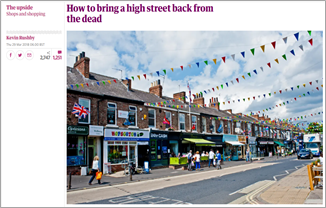 arch 2018.
arch 2018.
The article uses the 2015 winner of the Great British High Street Awards – York’s Bishopthorpe Road – as an example of a vibrant High Street and asks whether the Bishopthorpe Road ‘model’ could be used nationwide. The article was shared 2,746 times on Facebook and commented upon 1251 times on the Guardian website.
Bigram and Trigram
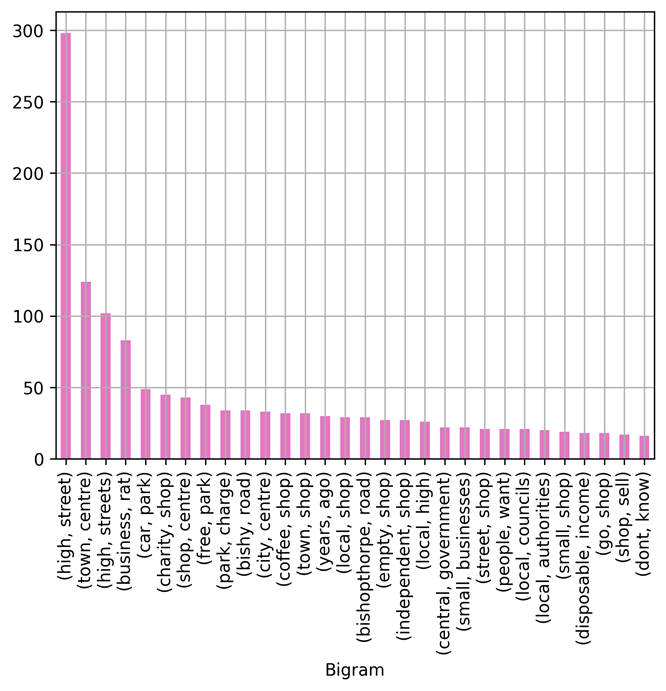

Sentiment Analysis and Word Frequency

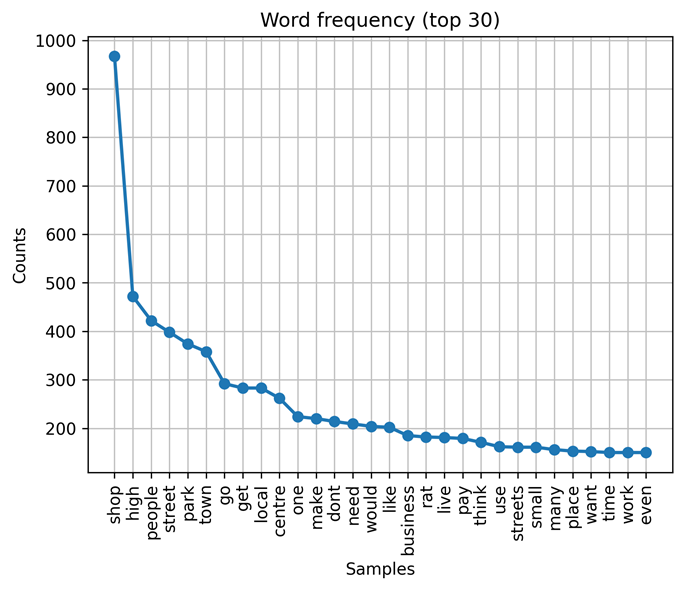
Comment length and recommendations
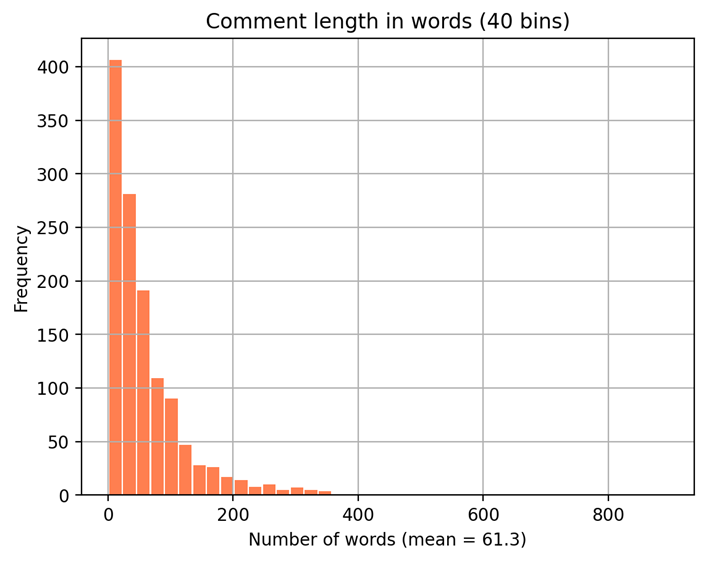
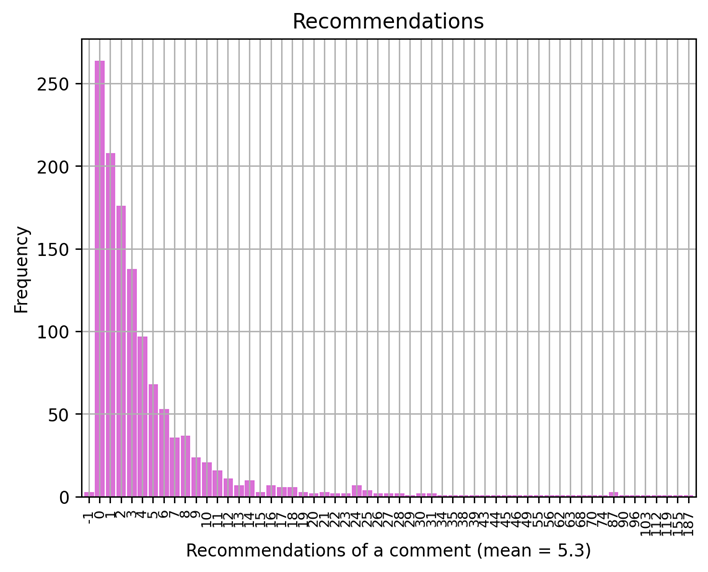
HS.1. Key points of analysis
Bigram and Trigram analyses (along with the word frequency analysis) suggest that key issues raised by commenters of this article revolve around the following points:
- (Lack of) Accessibility to High Streets and Town Centres (see ‘car, park’ in bigram; ‘double, yellow, line’; ‘within, walk, distance’; ‘free, car, park’ in trigram; park and town in the word frequency).
- (High) Business rates (see ‘business, rate, small’ in trigram; business and rate in the word frequency).
- Goods and services offered by High Street shops – and whether or not they might be attractive to consumers (see ‘people, want’ in bigram; ‘something, want, afford’ and ‘offer, something, want’ in trigram).
This is further emphasised by a qualitative analysis of the most recommended comments. See for instance the two comments below:
“Eight years of austerity is bound to affect people's shopping habits. As someone who runs a shop, I have what is considered cheap High Street rent at £600pcm (soon to be £640pcm). Trying to make those payments is getting increasing [sic] difficult as folk prefer to shop online rather than support their High Streets. Towns are becoming more like ghost towns and unless austerity is stopped and reversed to increase purchasing power and councils buy more shops to let back to shopkeepers at affordable rents, I can only see more shops being converted into flats” (recommended 119 times).
“Introduce better urban cycling infrastructure. Cyclists visit shops more regularly than users of other forms of transport and have been shown to increase trade for local business by as much as 50%.It's no surprise the case study here is York; one of the top five cities in the UK for journeys by bike” (recommended 103 times).
The sentiment analysis suggests that although a majority of commenters engaged positively with the example of Bishopthorpe Road as a vibrant High Street, a significant number expressed doubts about the potential to apply or transfer York’s model elsewhere.
The average comment length (61.3 words) and the average number of times a comment was recommended (5.3 times) both suggest that readers engaged fairly well with the topic. This provides a baseline for comparison with similar articles published subsequently.
 HS.2 – May 2020 perceptions (Covid-19 first wave)
HS.2 – May 2020 perceptions (Covid-19 first wave)
Article 2 ‘Coronavirus has emptied public spaces – but it could reinvent the High Street’ was published online in May 2020.
The article argues that business models reliant on maximum footfall are at odds with social distancing, leaving space for local shops and mutual aid.
The article was shared 87 times on Facebook and commented upon 258 times on the Guardian website.
Bigram and Trigram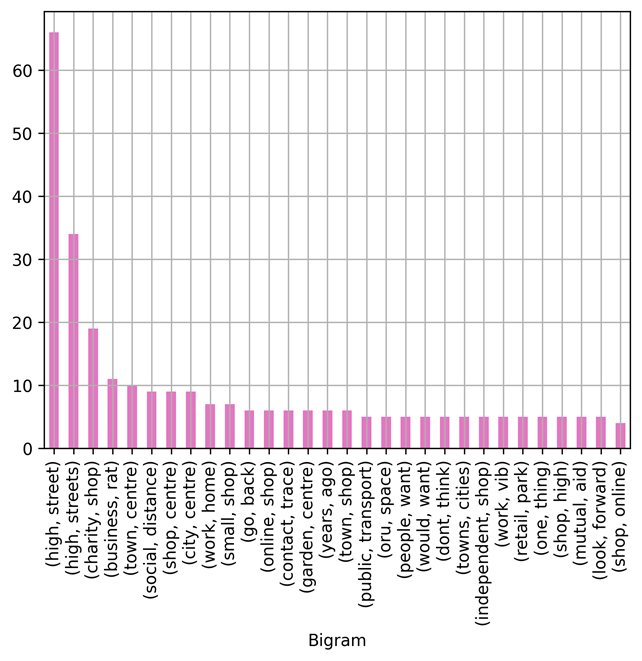
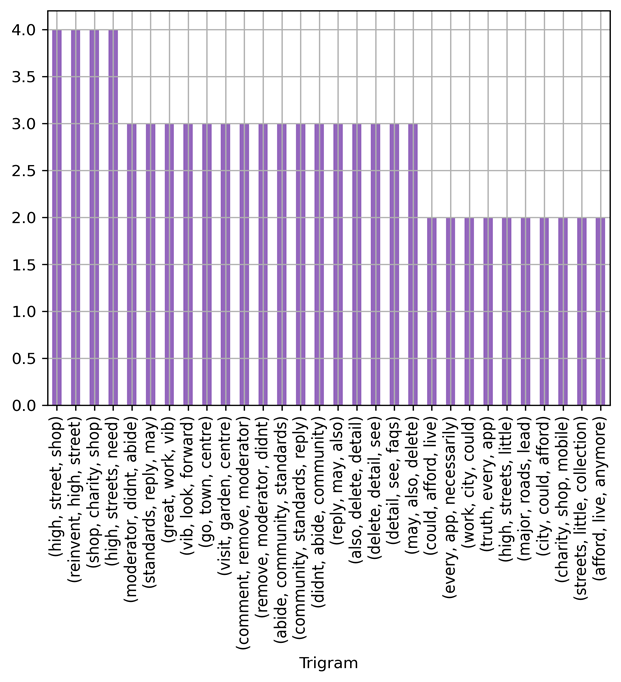
Sentiment analysis and word frequency
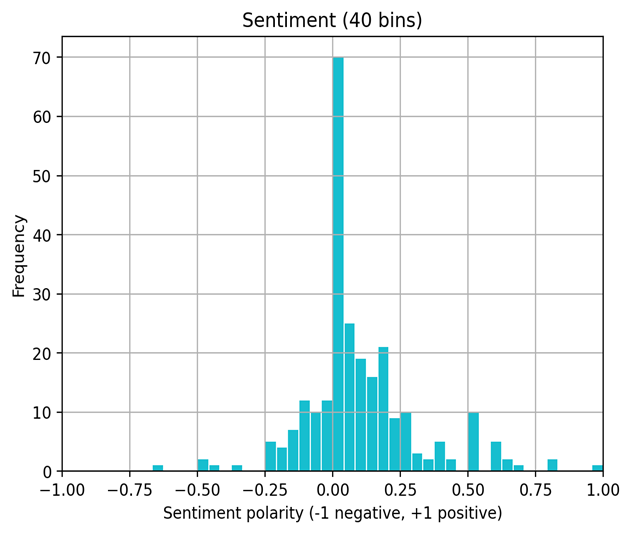
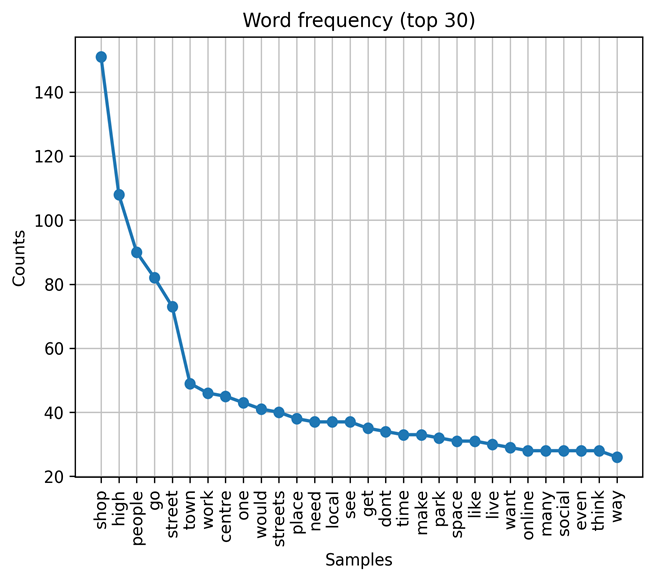
Comment length and recommendations
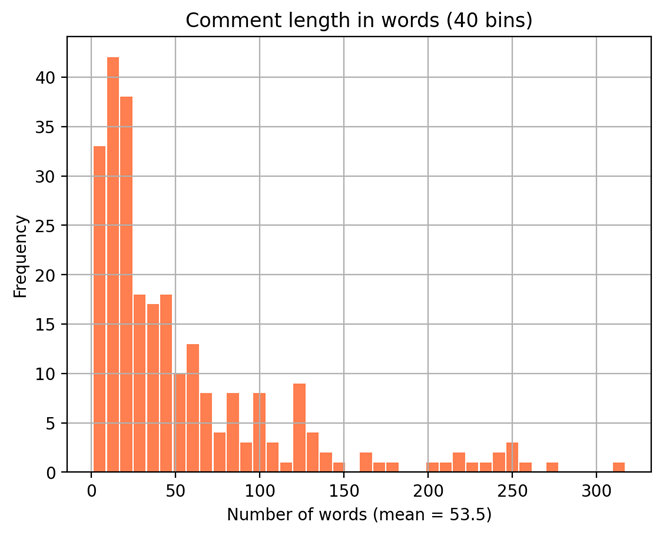
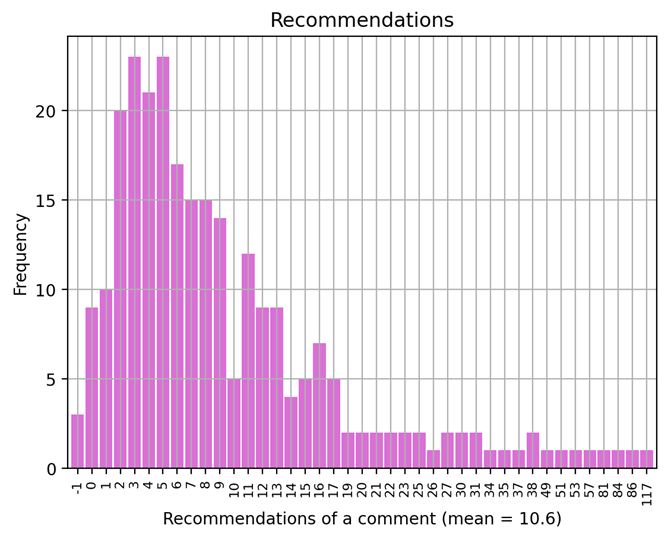
HS.2. Key points of analysis
Analyses of readers’ comments in May 2020 (at HS.2.) after the onset of the pandemic suggest an echoing of similar issues previously raised by commenters in March 2018 (at HS.1).
(High) Business rates were mentioned again as a key problem (see ‘business, rate’ in bigram) along with issues around accessibility (see, ‘major, roads, lead’ in trigram and ‘park’, ‘space’ in word frequency).
Similarly, the issue around the type of goods and services offered by High Street shops was one of the most recurring topics featured in the comments (see ‘charity, shop’ in bigram). Although it should be noted that this topic was addressed in the context of social distancing measures that were in place at the time (see, ‘social, distance’ in bigram) and increased online shopping (see, ‘every, app, necessarily’ in trigram and ‘online’ in word frequency).
Two major points that emerge from the HS.2 (May 2020) analyses are:
- the perception (expressed by online commenters) that Coronavirus is simply accelerating changes that were already taking place and affecting the High Street before the pandemic; and
- the necessity to put the consumer (and/or the consumers’ experience) back at the heart of High Streets and Town Centres.
The above two points are expressed particularly well in some of the article’s most recommended comments:
“[…] most High Streets are little more than a collection of charity shops, mobile phone vendors, fast food joints and cafes. They are also devoid of parking space, and lacking in public transport. What shops there are, are open during exactly those times of the day when the majority of adults are at work - and they close at the same time that those workers would be free to go and buy stuff. What "proper" shops there are can only sell you the stuff they have - not the stuff you want to buy. They also have to pay high rents, higher business rates and the cost of at least one person for all the hours they are open, plus heating and lighting. So because of their overheads (and low turnover) they are not cheap places to frequent. The High Street has been in decline for decades. One thing that Coronavirus is doing is speeding up change. We have had the technology for mass home working for some years now. It has only taken off since people have changed their minds about using it. The decline of the High Street will be further accelerated by all the social changes that this pandemic is bringing about. For example: all the people who have never considered home shopping, or internet shopping […]. (Recommended 117 times)[7].
“The idea that we're going back to the 1956-style High Street is just wishful thinking. Just in case you haven't spotted it, there's no social distancing on the internet. No need to queue up for the privilege of seeing a limited range of goods. High Streets have to learn to put their customers first rather than treat them as an inconvenience.” (Recommended 84 times).
“I'm not a huge fan of towns and cities which often have the same High Streets and the same chain shops and restaurants. When I go to other European countries, I find their urban centres often have regular markets, mini festivals, lots of independent shops and cafes, interesting street furniture and sculptures and pockets of pleasant social spaces where people can get together and socialise or watch the world go by. I'd probably shop in our urban centres more if they had something to attract me”. (Recommended 38 times).
The sentiment analysis suggests that commenters mostly agree with the main argument expressed in the article – viz., the prospect for local shops to fare better than larger shopping areas under lockdown measures.
The average comment length (53.5 words) is slightly below the average length of the previous article. However, the average number of comment recommendations (10.6 times) is twice as high as the previous article. This indicates quite a large degree of agreement among online readers.
 HS.3 – June 2020 perceptions (High Street Shops imminent reopening)
HS.3 – June 2020 perceptions (High Street Shops imminent reopening)
Article 3 ‘After Covid we're going to need a serious urban regeneration plan’ was published online in June 2020 – just a few days before the re-opening of High Street shops.
The article argues that to revitalise High Streets, the government must urgently devise a strategy to devolve both power and money to a local level. The article was shared 69 times on Facebook and commented upon 597 times on the Guardian website.
Bigram and Trigram
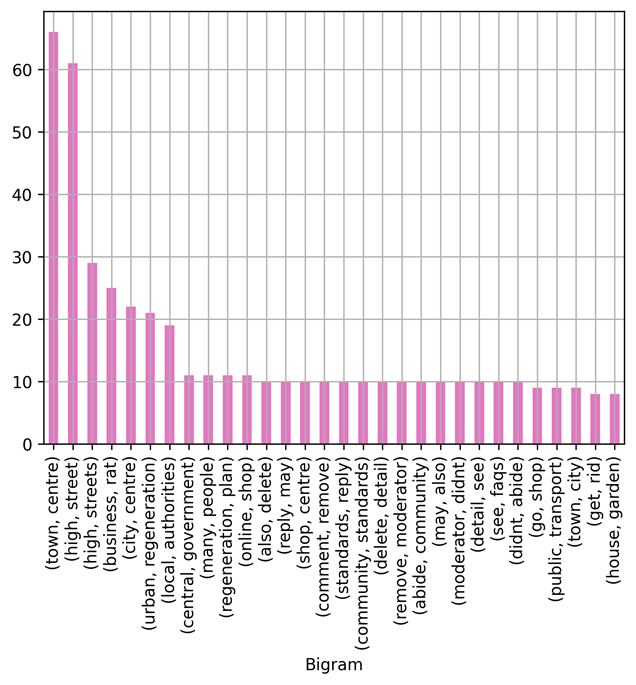
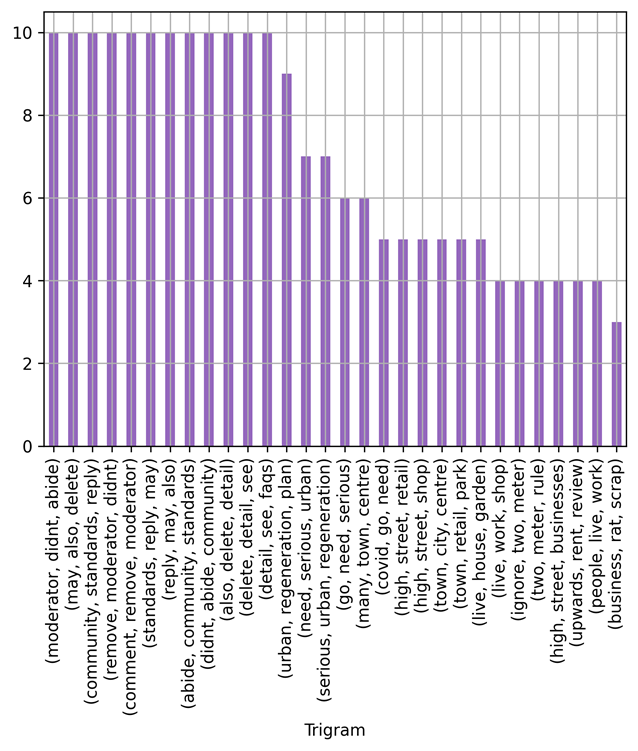
Sentiment analysis and word frequency

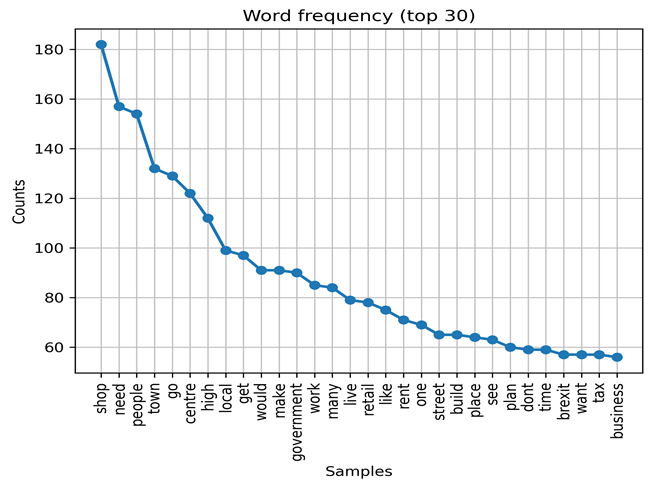
Comment length and recommendations
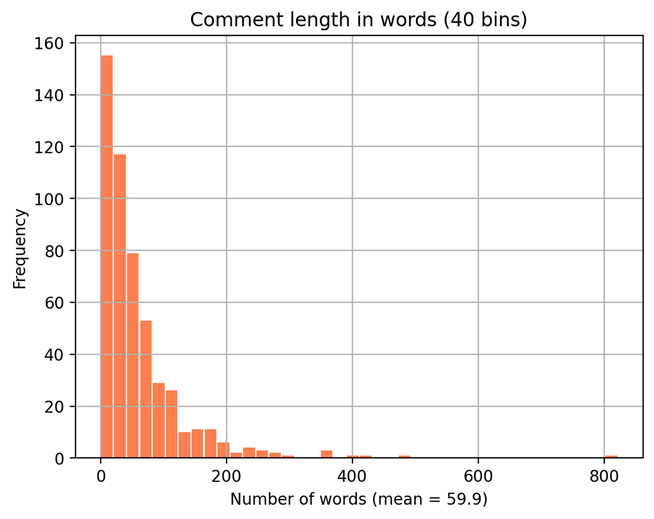
HS.3. Key points of analysis
Bigram and trigram analyses for this article display both similarities and differences when compared with the previous two articles. Once again, issues around business rates along with (high) rents and the legal obligations of retail property tenants were raised by online commenters (see 'business, rate' in the bigram and 'business, rate, scrap' in the trigram analysis).
These points are expressed particularly well in one of the article's recommended comments:
"Having previously owned High Street businesses the economics of the business must work for it to survive and that applies to all businesses. A few significant issues are:
1. Business rates- these should be scrapped and replaced with a turnover or profit related tax. Alternatively factor in the rates in to the quarterly VAT returns.
2. Rent - landlords are mostly living in cloud cuckoo land. Rents are vastly inflated and based and [sic] the golden glorious times when retail reigned supreme of 30 years ago. Rents must be flexible and possible to move down as well as upwards. Scrap 'upwards only' rent reviews. Base rent on a proportion of turnover instead. Again, it could be based on VAT returns.
3. Overly burdensome legal obligations on the tenants of retail properties. Many entrepreneurs who sign up for commercial leases do not realise that the obligations of the lease continue even after the lease is reassigned to another lessee[8] " […]. (Recommended 58 times).
New themes emerging from our HS.3 analyses revolve around ‘adaptation’ and the potential to ‘re-purpose’ old buildings in city centres – more specifically, the idea that Town Centres have evolved throughout the years and will continue to do so while adapting to new circumstances created by the pandemic. This is illustrated by words such as ‘urban, regeneration’ and ‘regeneration, plan’ in the bigram analysis and further exemplified by the comment below:
“Is it just me or is everyone getting tired of all these post-covid must-dos. Town centres constantly evolve; over the past 50 years we have seen the growth of the chain stores, the birth of supermarkets and then out of town stores. Throughout this our spending habits have changed. Town centres are sitting on a pile of real estate. If they do not have shops they have offices, if they don't have offices they have flats. It is that simple. Why do we need this silly knee-jerk attitude of painting a picture of depravation (blamed on the Tories) and a call for more of our money to be thrown at the problem. Local councils just need to designate a right-size town centre and allow the remainder to be re-used for other purposes. Far from needing money they get income from conversions in planning fees, 106 agreements and extra council tax”. (Recommended 35 times).
Finally, an important point raised by commenters related to the effect of Brexit on the High Street (a point touched upon by the article’s author Larry Elliott). How High Streets will survive the economic impact of the UK’s exit from the EU was often questioned and discussed by commenters, as illustrated below:
“[…] Go on then... Explain why Brexit will have a negative effect on the High Street.
Do you really need it spelling out? More unemployment, less money in the economy, more expensive imported goods... you want me to go on?” (Recommended 27 times).
The Sentiment analysis shows a relatively negative engagement of commenters with the article (which might be related to the specific challenge presented by Brexit for consumers and retailers). The average comment length (59.9 words) is similar to that of the earlier articles analysed. The average number of times a comment was recommended (3.6. times) is a lot less frequent than in the previous articles. This could indicate a higher level of disagreement among online readers and/or a focus on a wider range of different topics addressed in the article comments.
 HS.4 – July 2020 perceptions (High Street Shops reopened with Social distancing measures)
HS.4 – July 2020 perceptions (High Street Shops reopened with Social distancing measures)
Article 4 ‘I relish the return of life to our High Streets. But our second-rate leaders need a bolder vision’ was published online in July 2020. The article argues that while important challenges face the High Street (and the broader economic sector) the government is ill-prepared to tackle them.
The article was shared 143 times on Facebook and commented upon 759 times on the Guardian website.
Bigram and Trigram
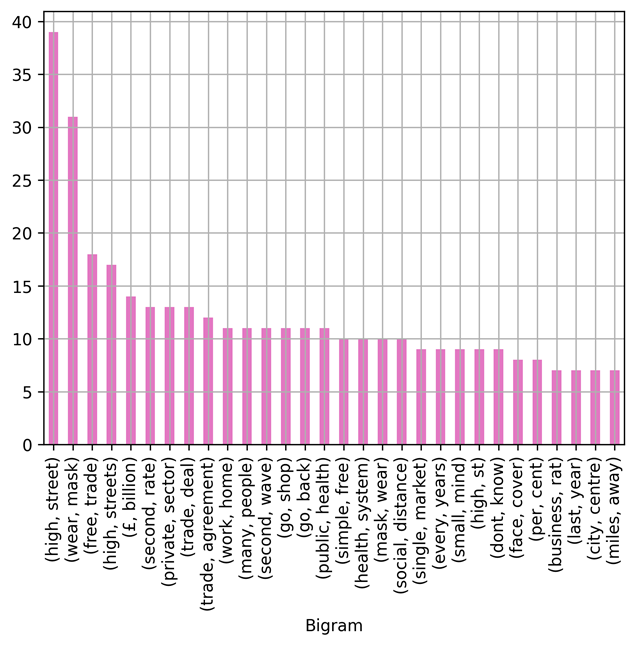
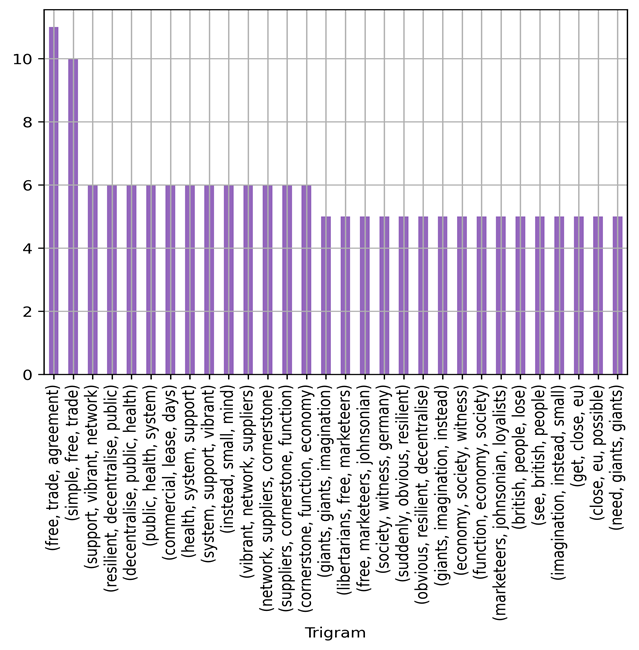
Sentiment analysis and word frequency

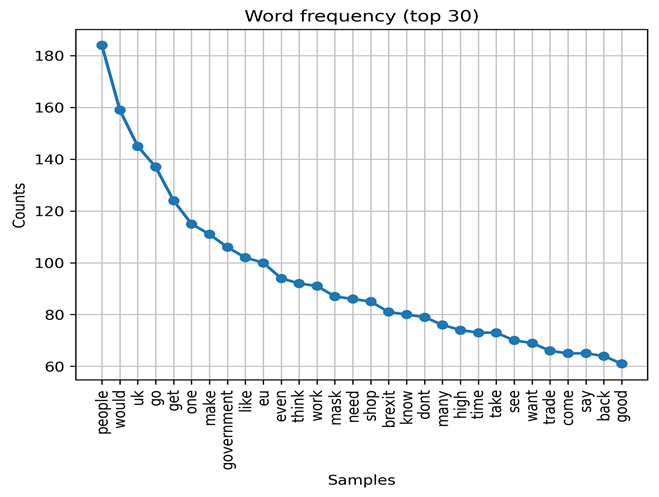
Comment length and recommendations
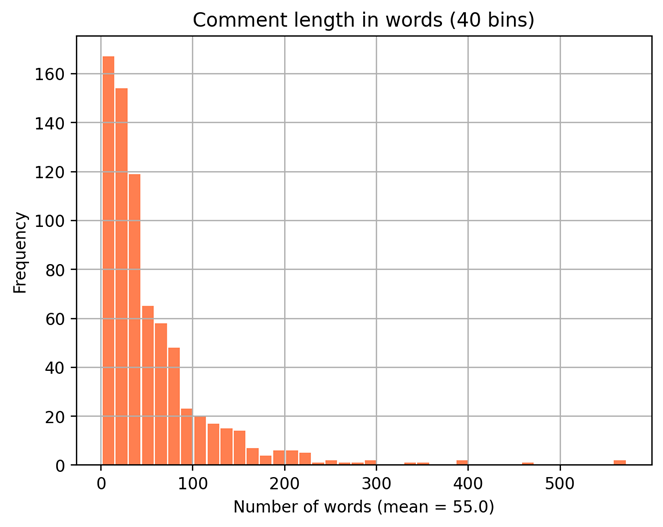
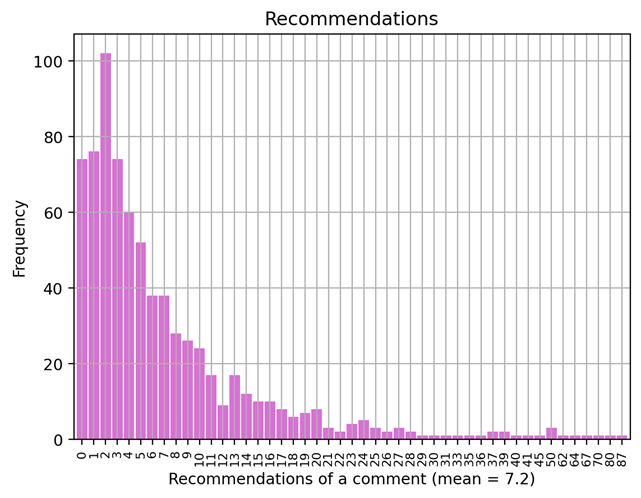
HS.4. Key points of analysis
Bigram and trigram analyses of comments posted in July 2020 (viz. HS.4) indicate a continued emphasis on economic barriers preventing the High Street from thriving. Once again, ‘business, rate’ was mentioned by commenters. Ideological (viz. ‘libertarian’) reasons were also thought to be behind the inevitable decline of the High Street. This is illustrated by words such as ‘private, sector’ in the bigram and by ‘libertarians, free, marketers’ in the trigram analyses. This is expressed particularly well in one of the most recommended comments:
‘You'll never get the High Street back until the High Street is owned locally and not in mega-corps. 40 years ago the breweries realised they could make more money screwing over tenants than selling beer. Our small town is turning into a food & coffee & charity shop wasteland. The last bank is teetering and soon the only reason to go into town will be to dump stuff at the charity shops. If this causes a property price collapse and a government review of rates then, and only then will it be worth investing in developing a retail business in one of the High Street shops. Even then, if it is successful, a private landlord will probably increase the rent to kill it off’ (Recommended 50 times).
In addition, an important issue that (according to commenters) explains the High Street’s difficulties in ‘bouncing back’ and attracting customers is the government’s rather chaotic management of the pandemic. In particular, commenters raised questions about whether or not masks should be worn (see, ‘wear, mask’ in the bigram analysis; ‘mask’, ‘need’, ‘shop’ in the word frequency) and problems surrounding the implementation of social distancing measures in shops (see for instance, ‘social, distance’ in the bigram) as examples of this chaotic management.
Another point emerging from the analyses revolves around the lack of ‘social interactions’ defining – according to online commenters – new shopping experiences as well as new human interactions in broader terms:
‘l yearn for a High Street where we once had a butchers, a bakers , a greengrocers and all the other small shops we had in the past. Back in the older days people talked to each other where now the vast majority are more interested looking at the smartphones now rather than talking to their fellow humans. It’s an indictment of our disposable modern society sadly’ (recommended 50 times).
The sentiment analysis suggests that online commenters were on the whole sympathetic to the main argument developed by the author – namely, that the inadequacy of the government to deal efficiently with the economic and public health challenges have affected (and are likely to continue to affect) the High Street. The average comment length (55.0 words) is in line with the previous articles. The average number of times a comment was recommended (7.2 times) is higher than in June 2020 (HS.3) which could indicate a larger degree of agreement among readers about the issues raised in the comments.
 HS.5 – August 2020 perceptions
HS.5 – August 2020 perceptions
Article 5 ‘we fixate on the decline of the High Street, but the real issue is Amazon’ was published online in August 2020.
The article argues that while politicians talk about saving traditional shops, they should focus efforts on challenging the vast power of the tech giant (Amazon). The article was shared 2,206 times on Facebook and commented upon 984 times on the Guardian website.
Bigram and Trigram
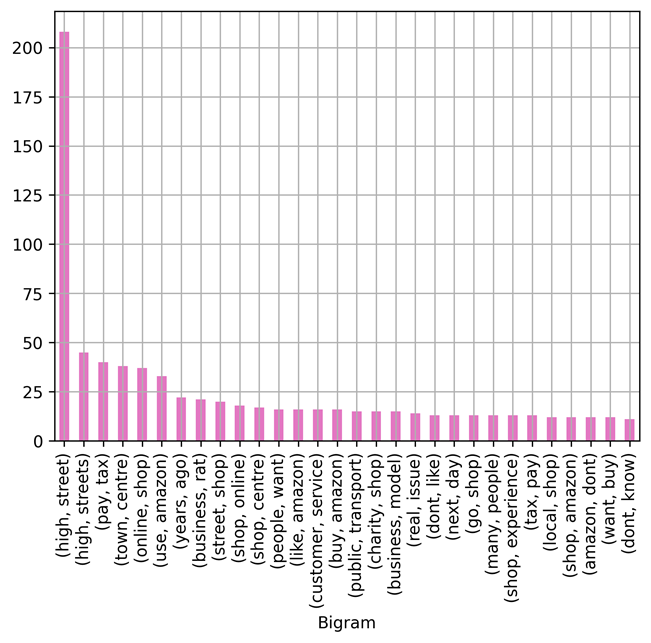
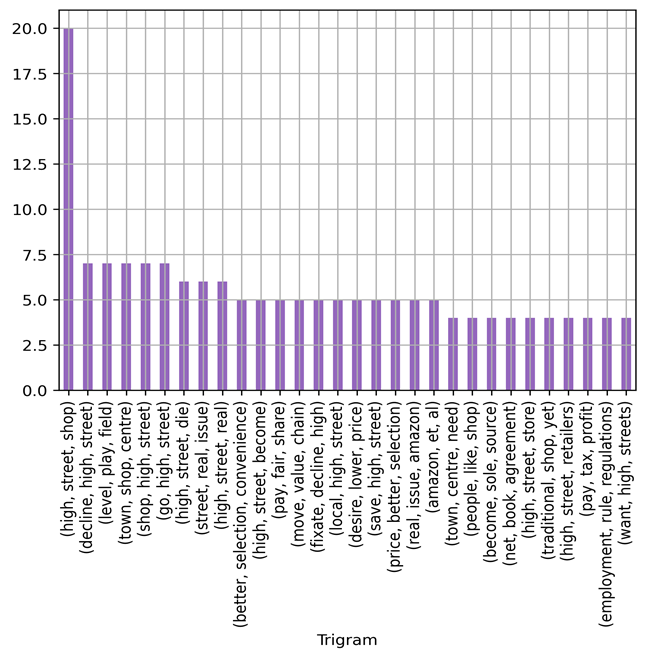
Sentiment analysis and word frequency
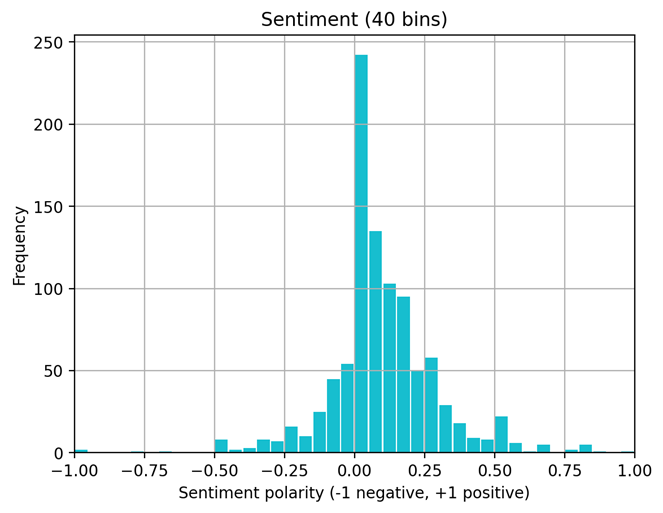

Comment length and recommendations
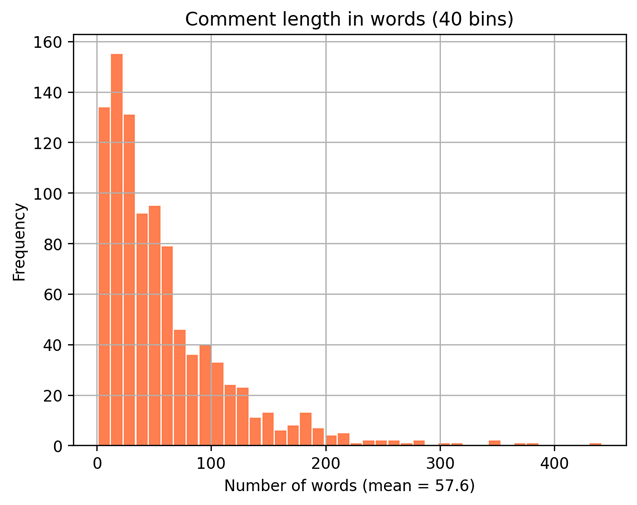
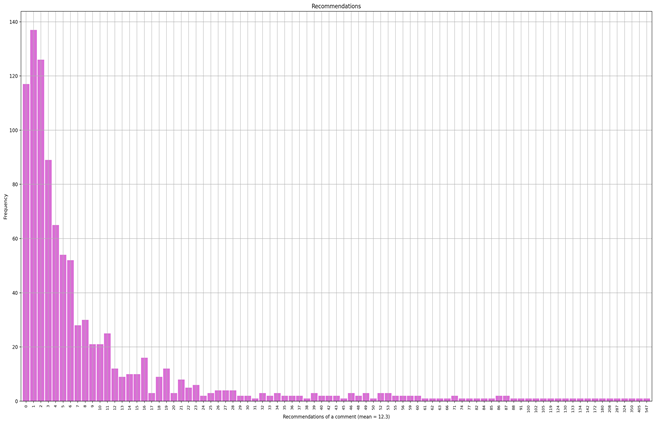
HS.5. Key points of analysis
Bigram and trigram analyses intimate that readers commented upon a vast array of topics relating to the article.
Issues around (high) rents and (inadequate) parking spaces were, once again, mentioned quite frequently – see, for instance, ‘business, rate’ and ‘public, transport’ in the bigram analysis – with some commenters suggesting that the decline of the High Street started well before the advent of online shopping and others arguing for an online sales tax to protect High Street retailers. See for instance:
‘The old fashioned but excellent High Street family run shops were killed off by the supermarkets, by predator landlords, by the rating system and by greedy local authorities that viewed parking as a gold mine rather than a service long before Amazon was even thought of’[9] […]. (Recommended 350 times).
‘Until we even up the tax take from High Street shops, and on-line sales, then there'll always be an advantage to the pure on-line sales companies’. (Recommended 208 times).
Consistent with comments left under the previous article (HS.4), some commenters mentioned that evolved shopping habits have brought about the need to repurpose buildings and town centres altogether:
‘The concentration should be on finding a useful purpose for our town centres. People aren't going to shop the old way’. (Recommended 324 times).
Also consistent with earlier comments, public health and safety issues were cited by commenters as one of the main reasons for not visiting High Street shops. Although people might normally be inclined to shop locally, fear of getting ill and then having to self-isolate may explain why many have turned to online shopping (even if only temporarily):
‘At the risk of being 'persona non grata' having to self-isolate because I have my old and vulnerable mother living with me during the unpleasantness amazon [sic] has been an absolute godsend for us. As someone who has always shopped locally my heart goes out to the inevitable massacre that is coming to the jobs of people I know and I miss. Sorry, but that's the reality until we can get a grip on this’. (Recommended 180 times).
Finally, and also reiterating points already made, online commenters mentioned that they were not inclined to visit High Streets because (a) they fail to deliver the goods and services they need (see for instance, ‘better, selection, convenience’ in the trigram analysis) and (b) they are unappealing places to visit and socialise. This is expressed particularly well in the two comments below:
[…] “I try and support my local shops as often as possible; butchers, bakers, candlestick makers etc., but I just don’t need that much artisanal hand crafted Peruvian beeswax these days. I suppose I could make far more of an ethical decision about my consumer habits, but most of the High Street names and mainstream alternatives have wobbly moral compasses too’[10] […]. (Recommended 547 times).
[…] “the problem in Britain is that so many town centres are just unappealing places to be, modernise buildings that need modernising, make the architecture look more harmonious, it has been done in parts of central London such as the Brunswick centre in Bloomsbury that has been turned into an attractive shopping and eating area which used to be grey and bleak. Many European cities still have bustling town centres because they are just nice places to wander and socialise, I think we can do the same[11]” (Recommended 142 times).
The sentiment analysis suggests that online commenters were broadly on board with the main argument developed by the author – viz. focusing on ‘fixing’ the traditional High Street is a distraction from the key issue surrounding the workings of online businesses and specifically challenging their vast power.
The average comment length (57.6 words) is consistent with the previous articles examined in this study. The average number of times a comment was recommended (12.3 times) is the highest average of all the previous articles. This indicates a high degree of engagement with the topic from online readers.
Summary and conclusion
Each of the five articles examined in this Study considered the problems facing the High Street from different angles. For example, the impact of social distancing measures, the potential implications of Brexit, and the exponential rise of Amazon. Despite this, it is of note that online commenters often raised similar points and expressed similar concerns under each article.
Different circumstances… same issues
Commenters cited similar reasons for not visiting their High Streets before the onset of Covid-19, after the onset of Covid-19 and throughout the pandemic. Three problems were mainly identified:
- Business rates
- Access to High Streets (especially parking spaces)
- Goods and Services offered by High Street shops
Business rates were mentioned by commenters under every single article analysed in this study (with quite a few High Street shop owners mentioning that business rates were one of the most significant barriers to running a successful business).
A 'catalyst for change'
Some commenters mentioned that fear surrounding the contraction of Covid-19 had influenced their decision to cease visiting their local shops as frequently as they otherwise would. This suggests, perhaps, that once this fear is mitigated, usual (i.e. pre-Covid-19) High Street and Town Centre shopping habits will be able to resume. However, a large number of commenters suggested that Covid-19 had simply accelerated some of the changes that were already affecting the High Street before the pandemic. This may suggest that unless the issues outlined above (i.e. around goods and services as well as access) are addressed, visits to local shops may continue to decline post Covid-19.
No going back, no problem
Along with the view that retail is unlikely to regain its position in the High Street, there appears to be general consensus among commenters that there will be ‘no going-back’ to previous shopping habits. Quite a few commenters were also convinced that (as a consequence) a potential way forward will be to focus on the re-purposing of buildings in city and town centres. After all, city centres have adapted to important changes in the past and will therefore be required to adapt to future changes too. Some commenters suggested that this is also an opportunity for High Streets to tackle wider problems:
‘Turn High Streets into residential properties to tackle homelessness and/or green spaces that will improve wellbeing and help the environment. If retail chains die out make it easier for local, independent businesses to move into the empty units’.
Two potential solutions mentioned repeatedly by commenters to make High Streets and Town Centres more attractive places to visit are to:
Follow the example of other European cities
Other European cities (especially Italian and French cities) were often cited as examples of vibrant and attractive centres to visit mainly due to their variety of independent shops and restaurants. Accessibility (via cycling facilities and pedestrian routes) was often mentioned as a great asset, along with markets and festivals – all facilitating social interactions and enhancing the quality of ‘experience’.
Socialise, Socialise, Socialise
With reduced face-to-face contacts with family, friends and colleagues, commenters suggested that High Streets could be revitalised as a hub for social interaction. This (according to commenters) will require ‘human interactions’ to be put back into the heart of town and city centres, and could be facilitated by a more inclusive approach by aligning the solutions to localised (economic) challenges with solutions to wider global and national issues (i.e. Climate Change and planning for an elderly population).
Conclusion
The Covid-19 outbreak has come at a challenging time for many High Streets and Town Centres already suffering from reduced footfall. The results of our research suggest that there is an alignment between expert and public views on the potential long-term implications of the pandemic on the High Street. One possible explanation for this alignment of views could be that readers inclined to comment on the various newspaper articles might also be ‘experts’ by virtue of being, for instance, High Street shop owners themselves. It is important to recognise, however, that a number of commenters have based their observations on their personal experiences of homeworking and new ways of shopping, online and/or locally.
While we expect social distancing measures to reduce over time, ‘hyperlocalism’ and homeworking are likely to continue to be a part of the new landscape. Experts have predicted that as we have already seen an increase in demand for flexible working arrangements and homeworking, it is likely that a number of sectors will follow the example of technology companies that have already announced a move to homeworking practices (utilising offices as a central hub).This would imply that existing High Streets in larger Town Centres that have traditionally benefited from office worker demands may, in the long term, be required to adapt to accommodate other sources of footfall. This would include residential dwellings (e.g. later living), educational establishments, healthcare facilities and community uses.
Our analyses suggest that despite the somehow radical aspect of these changes, many commenters believe that the re-purposing of existing buildings in city/town centres is inevitable, and to be welcomed. As new shopping habits have started, and will continue, to transform the High Street, there is little doubt among online commenters that city centres will be able to ‘take the blow’, adapt and thrive again.
This readiness to accept that High Streets and Town Centres will inevitably change is perhaps worth noting from a policy perspective, especially while current government schemes and initiatives (according to commenters) wish to ‘resuscitate’ old High Street models (viz. the 50-60s’ shopping style). Although paradoxically, aspirational city centre models cited by online commentators (e.g. Italian and French cities and/or places of social interactions) are actually quite reminiscent of ‘old shopping places’ – that is, High Streets made up of independent retailers.
Of course, our study has many limitations. First, it lacks spatial considerations taking into account only the experiences and predictions made by commenters based on the opinions expressed rather than on systematic data (including geographical location). Second, with a bit more than 3,840 comments analysed, the results of this research cannot be generalised beyond the population sampled for the purpose of this study.
It is hoped, however, that this research will provide a springboard for future large-scale research. As social media activity can increasingly act as a barometer of the financial health of major retailors on the High Street, we also hope that online and social media analyses will be used more frequently to gather, understand and inform the future of the High Street and Town Centre.
Appendix
HS1 - 10 most recommended comments |
Recommend |
|
|
1 |
My local High Street seems to be trying a more radical approach involving vapeing shops, nail bars, mobile phone accessory shops, tattoo studios, 99p stores, Turkish barbers and seasonal pop up firework/Christmas stores. |
187 |
|
2 |
Having run a shop in the UK for over a decade, i found very little support from government or councils. They wanted high rates, insisted I pay for my modest few cardboard boxes to be recycled (even though the waste was then picked up by regular bin men ...) and the most heinous crime, encouraged horrendous parking charges. Having moved to Australia, virtually all shop parking is free, for at least three hours, and many all day. When anyone threatens to impose charges, the public immediately responds by a boycott of the car park. Folk here are horrified at the charges imposed. Not only is the money involved huge, but in the seaside town where i worked, the variation of time and money over the day was so complicated that people either just stayed for an hour, or drove on through. Some were forced to leave half way through a meal because the charges changed after nine in the evening. I understand this is a good source of revenue for councils, but also a good way to totally choke small shops and cafes to death. |
155 |
|
3 |
Eight years of austerity is bound to affect people's shopping habits. As someone who runs a shop, I have what is considered cheap High Street rent at £600pcm (soon to be £640pcm). Trying to make those payments is getting increasing difficult as folk prefer to shop online rather than support their High Streets. Towns are becoming more like ghost towns and unless austerity is stopped and reversed to increase purchasing power and councils buy more shops to let back to shopkeepers at affordable rents, I can only see more shops being converted into flats. |
119 |
|
4 |
To be fair the Pig and Pastry prices look quite reasonable however my point is that this area must be quite affluent to support these types of business and this High Street is a far cry from many provincial town centres. |
112 |
|
5 |
Introduce better urban cycling infrastructure. Cyclists visit shops more regularly than users of other forms of transport and have been shown to increase trade for local business by as much as 50%.It's no surprise the case study here is York; one of the top five cities in the UK for journeys by bike. |
103 |
|
6 |
Italian cities (mostly) don't have chains, or even supermarkets. You can walk across Rome and every cafe is different. The coffee is cheap (1 euro), delicious, and quickly served, not sweet frothy goo in plastic throwaways. The shop fronts don't dominate a street. Well done to Bishopgate, but it could do something about those awful shouty shopfronts that could be anywhere in the UK. A golden rule is to bar developers and big business - let real people devise their solutions. |
96 |
|
7 |
I don't know about the rest of the country but where I live if you want to shop on the High Street and take your car your choices are limited to either a maximum of 2 hours parking if you use the council owned car parks or paying private car park companies between £6.00 and £8.00 if you want to stay in town longer. |
90 |
|
8 |
Yes, asking local customers to support one's neighbourhood shop is sooooo presumptuous. I mean really, the nerve! |
87 |
|
9 |
Please don't ask financially squeezed customers to 'support' your shop. You have to offer something we want and can afford. If you don't then your business model is fatally flawed |
87 |
|
10 |
The death of the High Street started with single yellow lines, all the way up to double yellow lines. This forced UK shoppers online when that became popular, and made the UK the largest online shoppers. My local High Street endured the same issue, until shopkeepers forced the council to change the parking rules. That has now transformed our highstreet back to something resembling the old days. |
87 |
HS2 - 10 most recommended comments |
|
|
|
1 |
The typical local High Street, with a range of small stores providing essential daily goods, services and meeting places. But when you remove the rose-tinteds, you realise that most High Streets are little more than a collection of charity shops, mobile phone vendors, fast food joints and cafes. They are also devoid of parking space, and lacking in public transport. What shops there are, are open during exactly those times of the day when the majority of adults are at work - and they close at the same time that those workers would be free to go and buy stuff. What "proper" shops there are can only sell you the stuff they have - not the stuff you want to buy. They also have to pay high rents, higher business rates and the cost of at least one person for all the hours they are open, plus heating and lighting. So because of their overheads (and low turnover) they are not cheap places to frequent.The High Street has been in decline for decades. One thing that Coronavirus is doing is speeding up change. We have had the technology for mass home working for some years now. It has only taken off since people have changed their minds about using it. The decline of the High Street will be further accelerated by all the social changes that this pandemic is bringing about.For example: all the people who have never considered home shopping, or internet shopping. In the USA, Amazon is considered by some to be as much of a "basic utility" as water, electricity and the internet. That view will grow and the need for High Street shops will diminish further. Especially as they seem determined to not adapt to the 21st century - continuing as if this was 1950 ... right up until the time their owners lock the doors, roll down the shutters and hand back the keys. |
117 |
|
2 |
Yes, High Streets have set their opening hours so that their customers are pensioners, the unemployed and the dwindling number of housewives. Then they complain at the consequences. |
86 |
|
3 |
The idea that we're going back to the 1956-style High Street is just wishful thinking. Just in case you haven't spotted it, there's no social distancing on the internet. No need to queue up for the privilege of seeing a limited range of goods. High Streets have to learn to put their customers first rather than treat them as an inconvenience. |
84 |
|
4 |
"Create music, dancing, theatre in the streets and encourage Boules and children's games" in the High Street. Sounds like hell to me. If there's one thing that drives me nuts, when I'm in my local city centre it's flaming buskers’ caterwailing their usually off key, old pop songs. Kids in the High Street? Why would you, or them want to play there? When I was a kid, I played in the local parks, woods, swimming pools, and as a special treat the city centre pictures, or the ice rink, Why would they want to muck around in the streets? You seem to be one of these odd types, who want to cure the problems of the city by turning them in to not a city? Weird. |
81 |
|
5 |
"The safety of driving to shopping centres may go some of the way to counteract this, and the heavily surveilled, private-public enclaves will no doubt find ways to reinvent themselves, offering data-driven, tech-driven shopping experiences that fit seamlessly with contact tracing apps." Fucking hell just shoot me now. |
57 |
|
6 |
I'm sorry to say that with online retail we were moving away from the shopping High Street as a sustainable fixture. Chi-chi food markets are not going to save it either in the time of highly contagious pandemic. The question is, will this health crisis finish off the High Street completely? At the moment, it looks like it may only survive reinvented as the location for local services, from health to old age, libraries to child care. |
53 |
|
7 |
If small towns want to attract more people a good start would to make parking free. Who is going to pay to park when they can go to a supermarket and park for free. |
51 |
|
8 |
Humbled to have Oru Space featured here, we run this foodbank donation point with lots of volunteers from Goose Green Mutual Aid group! Big thanks to Sue King featured in this photo who has helped us hugely. |
49 |
|
9 |
I'm not a huge fan of towns and cities which often have the same High Streets and the same chain shops and restaurants. When I go to other European countries, I find their urban centres often have regular markets, mini festivals, lots of independent shops and cafes, interesting street furniture and sculptures and pockets of pleasant social spaces where people can get together and socialise or watch the world go by. I'd probably shop in our urban centres more if they had something to attract me. |
38 |
|
10 |
I'm inclined to believe anyone who refers to an area favouring pedestrians over cars as a "wasteland" is probably more interested in the opportunity to drive rather than the shopping part of any trip out. Out of town shopping parks are dead because they are stripped down to shopping in its purest form: acquire goods from maximum choice at cheapest price, in which case - unless you really like driving round dual carriageways – you might as well shop online and have delivered. Town shopping - and this only applies to towns which are actually pleasant - provide a richer, social and environmental experience; the shopping part is incidental. However if you spend this part itching at your driving gloves wondering when you're next going to get the chance show some Merc CDI what's what... |
38 |
HS3 - 10 most recommended comments |
Recommend |
|
|
1 |
And no mention of Brexit. Suggest you read Andrew Rawnsley's article, which is nearby. |
60 |
|
2 |
Having previously owned High Street businesses the economics of the business must work for it to survive and that applies to all businesses. A few significant issues are: 1. Business rates- these should be scrapped and replaced with a turnover or profit related tax. Alternatively factor in the rates in to the quarterly VAT returns. 2. Rent - landlords are mostly living in cloud cuckoo land. Rents are vastly inflated and based and the golden glorious times when retail reigned supreme of 30 years ago. Rents must be flexible and possible to move down as well as upwards. Scrap 'upwards only' rent reviews. Base rent on a proportion of turnover instead. Again, it could be based on VAT returns. 3. Overly burdensome legal obligations on the tenants of retail properties. Many entrepreneurs who sign up for commercial leases do not realise that the obligations of the lease continue even after the lease is reassigned to another lessee. Also, significant property costs, like repairing the roof on a building or refurbishment of communal areas of the building giving access to flats above the shop often fall on the business owner who rents the shop premises. These costs can be substantial and do absolutely nothing to increase the turnover or profits of the business. The landlord sits back and passes the costs for maintaining the building on to the shop keeper. There are plenty of other issues but the above are all solvable if the government ever has sufficient will to do so. |
58 |
|
3 |
LE never dares to mention Brexit, because he can see as clearly as anyone the economic disaster that he voted and argued for coming down the tracks at full speed. |
53 |
|
4 |
Is it just me or is everyone getting tired of all these post-covid must-dos. Town centres constantly evolve; over the past 50 years we have seen the growth of the chain stores, the birth of supermarkets and then out of town stores. Throughout this our spending habits have changed. Town centres are sitting on a pile of real estate. If they do not have shops they have offices, if they don't have offices they have flats. It is that simple. Why do we need this silly knee-jerk attitude of painting a picture of depravation (blamed on the Tories) and a call for more of our money to be thrown at the problem. Local councils just need to designate a right-size town centre and allow the remainder to be re-used for other purposes. Far from needing money they get income from conversions in planning fees, 106 agreements and extra council tax. |
35 |
|
5 |
The pandemic has made the need for action critical. Just about every pundit on the planet is using the same old formula: Everyone must do what I say because ...... Coronavirus. In the past, the reason given has been everything: the financial crisis, climate change, pollution, plastic bags, politics, socialism, automation, capitalism, consumerism, philosophy, nature .. the list is endless. But simply hiding behind the cause du jour is not a cogent argument. It may well be that the change being advocated is worthy, practical and beneficial. But to simply shout COVID! and expect everyone to fall in line, doesn't work. Show us good reasons. Argued logically. With tangible benefits and a way of getting from here to there. Then we will have something worth considering. Go on then... Explain why Brexit will have a negative effect on the High Street. Do you really need it spelling out? More unemployment, less money in the economy, more expensive imported goods... you want me to go on? |
28 |
|
6 |
And Brexit Larry don't forget its not quite as done as Bojo led the electorate to believe. No deal cliff edge, trade deal capitulation to US, tariffs from EU etc. Tough times ahead. |
27 |
|
7 |
Just about every article for the last ten weeks has said exactly that. 'Coronavirus...the world has changed...we must... insert writer's pet topic.' It's unbelievably formulaic and dull. |
27 |
|
8 |
No one is saying that Did you not get as far as the third sentence in the article? That is exactly what the author said! Here it is, again: The pandemic has made the need for action critical. |
27 |
|
9 |
I see your fellow Brexiteer Dan Hannan is now claiming that the arrival of 3.5million HK Chinese will be just the boost the British economy needs. Strange I haven't heard much from Farage and his followers on that particular issue I do hope they'll be just a welcoming. |
19 |
|
10 |
Individually, the best plan would be to get an EU passport and move somewhere else...Collectively, don't expect much from this Government. They are not made for these uncertain times. Hope for the best... |
19 |
HS4 - 10 most recommended comments |
|
|
|
1 |
Will is being very generous to the current cabinet by describing them as 'second rate'. I would consider 'tenth rate' more appropriate.The fact is that since the UK's calamitous referendum of 2016 it has had an increasingly foolish roster of Ministers and the compeition for the dimmest Minister of the past few years is very fierce. Raab. Bradley. Grayling. Johnson himself. And plenty more. Cabinet Ministers who have made it obvious that they are not capable of doing, or even understanding, the job. |
87 |
|
2 |
I was listening on R4 to an ex Labour voter from the red wall give our lamentable PM 9/10 on his performance so far, after one year in office. There lies the problem both the Labour Party and this country now faces. |
80 |
|
3 |
On a Beeb regional news programme two constituents in the former Labour stronghold of Mansfield gave Johnson 10/10 on his handling of the pandemic. There seems to be an alternative Universe! |
70 |
|
4 |
“There isn’t the local administrative capacity, let alone productive capacity, to do it.” |
67 |
|
5 |
All the UK is interested in is keeping all the benefits of being in the single market but without the obligations of maintaining a level playing field. |
64 |
|
|
I'm at a loss to understand why a two week warning was needed to 'prepare for masks in stores' whilst a few hours was sufficient for the complete disruption of flights from Spain. "Chaos thy name is Tory".. |
62 |
|
6 |
I’d give it up if I were you. |
50 |
|
7 |
You'll never get the high st back until the high st is owned locally and not in mega-corps. 40 years ago the breweries realised they could make more money screwing over tenants than selling beer. Our small town is turning into a food & coffee & charity shop wasteland. The last bank is teetering and soon the only reason to go into town will be to dump stuff at the charity shops. If this causes a property price collapse and a government review of rates then, and only then will it be worth investing in developing a retail business in one of the high st shops. Even then, if it is successful, a private landlord will probably increase the rent to kill it off. |
50 |
|
8 |
l yearn for a High Street where we once had a butchers , a bakers , a greengrocers and all the other small shops we had in the past. Back in the older days people talked to each other where now the vast majority are more interested looking at the smartphones now rather than talking to their fellow humans. |
50 |
|
9 |
You appear not to have heard of the colossally stupid no deal Brexit that the government is promoting |
45 |
|
10 |
At the start of the pandemic you can give grace for the enormity of the situation for things not done or done poorly. We were told science would lead us and guide our strategy... masks on, masks don't really do much, wear masks again but more often. Go on holiday without lockdown from certain countries... now, we have another change in directives which makes us looking like idiots. Our exit strategy is a joke really because our only tool other than Boris is isolation. What happened to track and trace, testing on arrival? There is no making excuses now. We are in the hands of utter fools and dishonest ones at that. |
41 |
HS5 - 10 most recommended comments |
|
|
|
1 |
Without truly realising it, Amazon has become my default setting for books, music, dog food, whiskey and most everything else. In the same way that Google is my default homepage and search engine. I also enjoy Prime delivery and some of their TV shows have been fantastic. I loathe shopping as an activity - shops and malls are soulless death to me - but I have to purchase and consume. We all have to. I try and support my local shops as often as possible; butchers, bakers, candlestick makers etc., but I just don’t need that much artisanal hand crafted Peruvian beeswax these days. I suppose I could make far more of an ethical decision about my consumer habits, but most of the High Street names and mainstream alternatives have wobbly moral compasses too. |
547 |
|
2 |
One of the main reasons I use Amazon, which I read very little about it elsewhere, is that if there is the slightest problem I get all my money back, and the goods returned at zero cost, without any argument. |
405 |
|
3 |
The old fashioned but excellent High Street family run shops were killed off by the supermarkets, by predator landlords, by the rating system and by greedy local authorities that viewed parking as a gold mine rather than a service long before Amazon was even thought of. Nobody gave a monkey’s fart about them. Now that the cash cows supermarkets and chain stores are threatened by Amazon we are all indignant like Eastbourne spinsters. |
350 |
|
4 |
The concentration should be on finding a useful purpose for our town centres. People aren't going to shop the old way! |
324 |
|
5 |
Why? Are you selling dodgy merchandise? |
287 |
|
6 |
Until we even up the tax take from High Street shops, and on-line sales, then there'll always be an advantage to the pure on-line sales companies. |
208 |
|
7 |
At the risk of being 'persona non grata' having to self-isolate because i have my old & vulnerable mother living with me during the unpleasantness amazon has been an absolute godsend for us. |
180 |
|
8 |
Amazon is successful too because it pays very little tax. |
172 |
|
9 |
Maybe make them more attractive places to just walk around? the problem in Britain is that so many town centres are just unappealing places to be, modernise buildings that need modernising, make the architecture look more harmonious, it has been done in parts of central London such as the Brunswick centre in Bloomsbury that has been turned into an attractive shopping and eating area which used to be grey and bleak. Many European cities still have bustling town centres because they are just nice places to wander and socialise, I think we can do the same. |
142 |
|
10 |
As a person who loathes shopping malls, too, I understand how easy it is for Amazon to be the first stop for all manner of purchase. What stopped me, though, was the fact they pay a fraction of the headline 19% corporation tax rate in the UK - less than 1% was paid on revenue of £10 billion last financial year. How can anyone compete? |
134 |
For more information about this paper contact [email protected] OR [email protected]
Tel: 020 7929 9494
Report contact
[1] Detailed analyses and discussions about ‘citizen planners’ can be found in Lord, A., Mair, M., Sturzaker, J., & Jones, P. (2017). ‘The planners’ dream goes wrong?’ Questioning citizen-centred planning. Local Government Studies, 43(3), 344-363.
[2] https://www.centreforcities.org/data/high-streets-recovery-tracker/ (Mapping City Centre Recovery.
Last updated: 11th November 2020) and https://www.oxford-covid-19.com/. Last updated 27th November.
[3] Covid-19 Supplement for town centres - The Grimsey Review (last accessed: 30th November 2020).
[4] See for instance: Good Growth by Design Recovery Roundtable High Streets & Town Centres (last accessed on 30th November 2020).
[5] There is an important body of work dedicated to text-mining techniques, N-gram analysis and Sentiment Analysis. See in particular, Ignatow, Gabe, and Rada Mihalcea. Text mining: A guidebook for the social sciences. Sage Publications, 2016.
[6] The 10 most recommended comments for each article are provided in the appendix of this report.
[7] A full version of this comment is provided in the appendix of the report (p.30).
[8] A full version of this comment is provided in the appendix of the report (p.31).
[9] A full version of this comment is provided in the appendix of the report (p.33).
[10] A full version of this comment is provided in the appendix of the report (p.33).
[11] A full version of this comment is provided in the appendix of the report (p.33).
